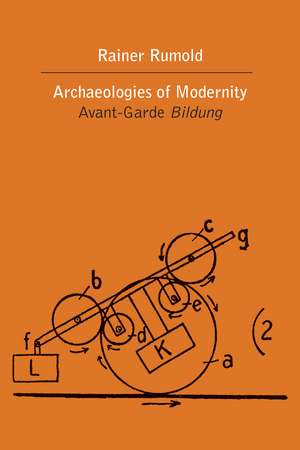Archaeologies of Modernity: Avant-Garde Bildung
Autor Rainer Rumolden Limba Engleză Paperback – 21 iun 2015
Archaeologies of Modernity explores the shift from the powerful tradition of literary forms of Bildung—the education of the individual as the self—to the visual forms of “Bildung” (from Bild) that characterize German modernism and the European avant-garde. Interrelated chapters examine the work of Franz Kafka, Jean/Hans Arp, Walter Benjamin, and Carl Einstein, and of artists such as Oskar Kokoschka or Kurt Schwitters, in the light of the surge of an autoformation (Bildung) of verbal and visual images at the core of expressionist and surrealist aesthetics and the art that followed. In this first scholarly focus on modernist avant-garde Bildung in its entwinement of conceptual modernity with forms of the archaic, Rumold resituates the significance of the poet and art theorist Einstein and his work on the language of primitivism and the visual imagination. Archaeologies of Modernity is a major reconsideration of the conception of the modernist project and will be of interest to scholars across the disciplines.
Preț: 268.68 lei
Preț vechi: 306.37 lei
-12% Nou
Puncte Express: 403
Preț estimativ în valută:
51.41€ • 53.04$ • 42.90£
51.41€ • 53.04$ • 42.90£
Carte indisponibilă temporar
Doresc să fiu notificat când acest titlu va fi disponibil:
Se trimite...
Preluare comenzi: 021 569.72.76
Specificații
ISBN-13: 9780810131125
ISBN-10: 0810131129
Pagini: 344
Ilustrații: 11 images running in text
Dimensiuni: 152 x 229 x 25 mm
Greutate: 0.45 kg
Editura: Northwestern University Press
Colecția Northwestern University Press
ISBN-10: 0810131129
Pagini: 344
Ilustrații: 11 images running in text
Dimensiuni: 152 x 229 x 25 mm
Greutate: 0.45 kg
Editura: Northwestern University Press
Colecția Northwestern University Press
Notă biografică
RAINER RUMOLD is a professor emeritus of German literature and critical thought at Northwestern University. His previous books include monographs on Helmut Heissenbuettel and Gottfried Benn; Eugene Jolas’s autobiography, Man from Babel, edited with Andreas Kramer; The Janus Face of the German Avant-Garde: From Expressionism toward Postmodernism (Northwestern, 2001); and Eugene Jolas: Critical Writings, 1924–1951, edited with Klaus H. Kiefer (Northwestern, 2009).
Recenzii
"Recommended." —CHOICE
"Rumold's encyclopedic knowledge of European modernism allows him to draw connections among a diverse group of thinkers and creative figures, who are seldom treated together within a single study... on the whole, his book is a thought-provoking review of the German historical avant-garde." —Seminar: A Journal of Germanic Studies
"This fascinating and wide-ranging book makes an eloquent argument for reconsidering the German avant-garde in around 1900–40. The avant-garde under discussion here comprises artists, writers and thinkers from Kokoschka to Benjamin who cut across conventional categorizations such as Expressionism, Dada, Surrealism or ‘theory.' Rumold’s ‘archaeological’ aim is to uncover the German avant-garde’s turns towards the visual, its desire for a pure imagery free from literary representation, the burden of history and Western conceptualizations of the self. According to Rumold, the avant-garde’s visual turns subvert the culture of metaphor perpetuated and institutionalized by literature, displacing symbolic representations of the Western subject into a range of pre-logical and progressive forms, figures, and ‘unsymbolizable, singular images.' Rumold maps a rich repertoire of avant-garde ‘image zones’ (the term is Walter Benjamin’s, from his 1929 essay on Surrealism), paying close attention to their historical and theoretical contexts as well as their shared modality which, he suggests, amounts to an interplay of materiality and mental creativity to give us ‘the sight, touch, feel, not of utopia, but of a ground unspoiled by hypertrophic conceptuality and metaphors.’ The book thus bears out the author’s claim to the productivity of thinking about the avant-garde’s visual turns, where previous accounts have emphasized its artistic and/or political failure." —Journal of European Studies
Descriere
Archaeologies of Modernity explores the shift from the powerful tradition of literary forms of Bildung—the education of the individual as the self—to the visual forms of “Bildung” (from Bild) that characterize German modernism and the European avant-garde. Interrelated chapters examine the work of Franz Kafka, Jean/Hans Arp, Walter Benjamin, and Carl Einstein, and of artists such as Oskar Kokoschka or Kurt Schwitters, in the light of the surge of an autoformation (Bildung) of verbal and visual images at the core of expressionist and surrealist aesthetics and the art that followed.
